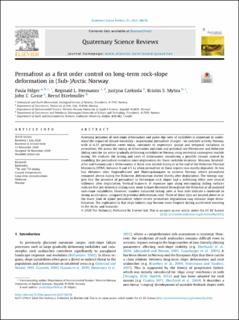| dc.contributor.author | Hilger, Paula | |
| dc.contributor.author | Hermanns, Reginald | |
| dc.contributor.author | Czekirda, Justyna | |
| dc.contributor.author | Sæterdal, Kristin Myhra | |
| dc.contributor.author | Gosse, John C. | |
| dc.contributor.author | Etzelmüller, Bernd | |
| dc.coverage.spatial | Norway | en_US |
| dc.date.accessioned | 2021-02-01T14:33:49Z | |
| dc.date.available | 2021-02-01T14:33:49Z | |
| dc.date.created | 2021-01-11T10:15:24Z | |
| dc.date.issued | 2021 | |
| dc.identifier.citation | Hilger, P., Hermanns, R. L., Czekirda, J., Myhra, K. S., Gosse, J. C., & Etzelmüller, B. (2021). Permafrost as a first order control on long-term rock-slope deformation in (Sub-)Arctic Norway. Quaternary Science Reviews, 251 | en_US |
| dc.identifier.issn | 0277-3791 | |
| dc.identifier.uri | https://hdl.handle.net/11250/2725639 | |
| dc.description.abstract | Assessing initiation of rock-slope deformation and paleo-slip rates of rockslides is important to understand the impact of climate variability - in particular permafrost changes - on rockslide activity. Norway, with 6–6.5% permafrost cover today, continues to experience spatial and temporal variations in permafrost. We assess the timing of deformation initiation and potential late Pleistocene and Holocene sliding rates for six active gradually deforming rockslides in Norway using terrestrial cosmogenic nuclide dating. We evaluate the timing and rates of deformation considering a possible climate control by modelling the permafrost evolution since deglaciation for three rockslide locations: Mannen, Revdalsfjellet and Gamanjunni 3. Deformation at these sites started during or at the end of the Holocene Thermal Maximum (HTM), between 8 and 4.5 ka when permafrost in those regions was mostly degraded. At two low elevation sites, Oppstadhornet and Skjeringahaugane in western Norway, where permafrost remained absent during the Holocene, deformation started shortly after deglaciation. The timings suggest that the presence of permafrost in Norwegian rock slopes had a stabilizing effect over several millennia after deglaciation. Vertical transects of exposure ages along outcropping sliding surfaces indicate that pre-historical sliding rates seem to have decreased throughout the Holocene at all analysed rock-slope instabilities. However, modern measured sliding rates at four sites indicate a moderate to strong acceleration, compared to previous deformation rates. Three of these sites are located above or at the lower limit of alpine permafrost, where recent permafrost degradation may enhance slope destabilisation. The implication is that slope failures may become more frequent during accelerated warming in the Arctic and Subarctic. | en_US |
| dc.language.iso | eng | en_US |
| dc.publisher | Elsevier | en_US |
| dc.rights | Navngivelse 4.0 Internasjonal | * |
| dc.rights.uri | http://creativecommons.org/licenses/by/4.0/deed.no | * |
| dc.subject | rockslides | en_US |
| dc.subject | 10Be and 36Cl dating | en_US |
| dc.subject | ground temperatures | en_US |
| dc.subject | long-term reconstructions | en_US |
| dc.subject | holocene | en_US |
| dc.title | Permafrost as a first order control on long-term rock-slope deformation in (Sub-)Arctic Norway | en_US |
| dc.type | Peer reviewed | en_US |
| dc.type | Journal article | en_US |
| dc.description.version | publishedVersion | en_US |
| dc.rights.holder | © 2020 The Author(s) | en_US |
| dc.subject.nsi | VDP::Matematikk og Naturvitenskap: 400::Geofag: 450 | en_US |
| dc.source.volume | 251 | en_US |
| dc.source.journal | Quaternary Science Reviews | en_US |
| dc.identifier.doi | 10.1016/j.quascirev.2020.106718 | |
| dc.identifier.cristin | 1868641 | |
| cristin.ispublished | true | |
| cristin.fulltext | original | |
| cristin.qualitycode | 2 | |

